|
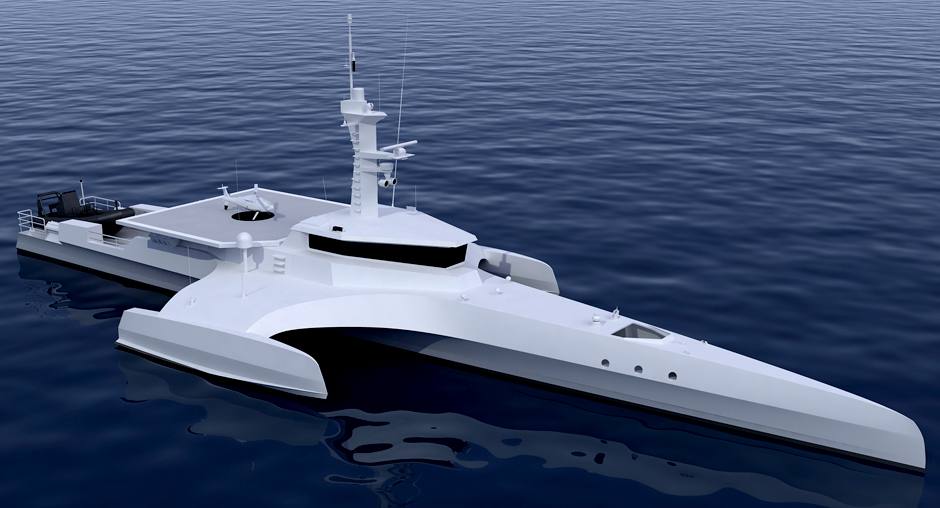
Okay,
it is bigger, but there
seems to be a family resemblance between the Ocean Eagle above and the Cable & Wireless Adventurer
designed by Nigel Irens

OCEAN
EAGLE - FEB 2014
A new concept of trimaran maritime surveillance vessel is under construction at the French shipyard of Chantier Mecaniques de Normandie in Cherbourg.
Based on a design developed by British naval architect Nigel Irens this new 43m long design offers very good fuel economy and an extended range to undertake both coastal and ocean monitoring and surveillance.
The design is based on trimaran experience developed from the Round the World record breaking vessel
Cable and
Wireless. This is based on a long thin centre hull that operates efficiently in displacement mode and this centre hull is stabilised by small side hulls supported by wing sections extending out from the main hull at about two third of the length from the bow. This concept has been proved to combine efficiency with excellent seaworthiness.
This new design is being built by CMN under a major contract that includes three of these offshore patrol vessels, three conventional 32m patrol boats and a series of 24 fishing vessels of 32m in length that the shipyard is building for the African country of Mozambique. The contract is part of a major expansion of the fishing capability of the country and Mozambique is expanding its enforcement capability with a contract for fast patrol boats placed at a Middle East yard. Whilst the focus of this development is on the expansion of the fishing industry the surveillance vessels are also likely to play a role on the development of the expanding offshore gas reserves in Mozambique.
The 43m vessels will be constructed in advanced composites using techniques that have been developed at the CMN subsidiary, JMV Industries, which has specialised in the construction of large composite designs for
racing
yachts. With its enclosed construction halls CMN will complete the outfitting fully under cover.
Called the Ocean Eagle, the new trimaran design will be powered by four Scania diesels, with each one producing 405kW. These will be coupled in the standard Servogear manner with one aft and one forward into a connecting gearbox that will drive the shaft. Twin Servogear controllable pitch propellers with provide the propulsion.
It is this propulsion system that contributes to the exceptional economy of the vessel. It allows the vessel to operate on just two of the four
diesels, allowing a 3,000 mile range at 18 knots. With all four engines coupled in the speed rises to a maximum of 30 knots. Operating at 12 knots, the range is 5,000 miles. CMN compares the efficiency of the Ocean Eagle to a standard monohull offshore patrol vessel of similar size by saying that the Eagle can operate for 238 miles on one tonne of fuel whilst the monohull would only cover 50 miles on the same amount.
The three vessels for Mozambique will be fitted with a helicopter deck aft of the central bridge structure. This will allow for the operation of unmanned air vehicles of up to 300kg, which can be used to extend the range of surveillance. The vessels will also be equipped to carry a 7m RIB tender with a launching ramp at the stern.
To add to the economy of this design it can operate with a crew of just 7 officers and ratings, with additional accommodation for 8 passengers. A wide variety of armament can be installed as well as extensive electronic detection and surveillance equipment.
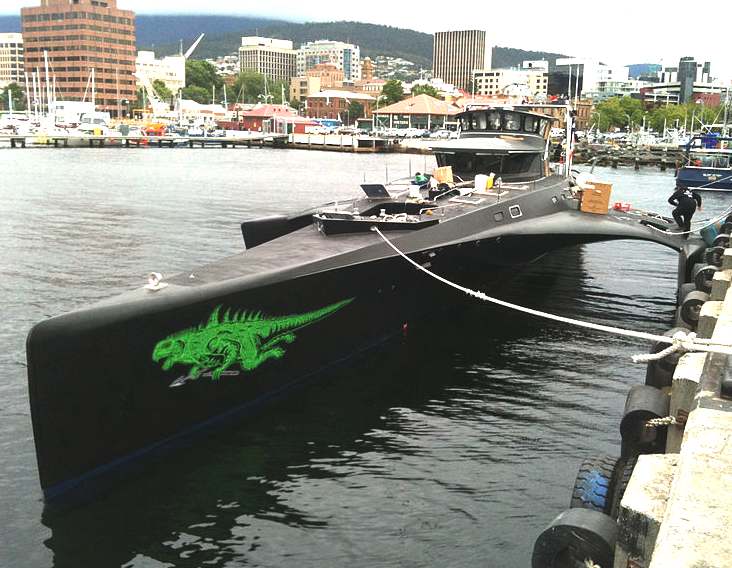
MV
Brigitte Bardot in her previous guise as Gojira
MV Brigitte Bardot (formerly Gojira and Ocean 7 Adventurer) is a
one of the first high-tech stabilized monohulls. She is 35 m (115 ft) long
with twin diesel engines and was designed by Nigel Irens.
A stabilized monohull may also be described as a trimaran with smaller
outriggers, the ultimate of which is possibly the latest research ship
(development tank test model) Bluefish
ZCC.
Construction of the
Adventurer began in June 1997 and she was launched on 16 March 1998. The official naming ceremony took place on 3 April 1998 in
London's
West India Dock.
CABLE
& WIRELESS ADVENTURER
Originally named the Cable and Wireless Adventurer she was built for the purpose of circumnavigating the world in less than 80 days. This was successfully accomplished in July 1998 in 74 days, 20 hours, 58 minutes, traveling more than 22,600 nautical miles (41,855 km). This achievement set a new
Guinness World Record for a powered vessel. However, on 27 June 2008 Earthrace (later renamed Ady Gil), the biodiesel powered wave-piercing trimaran, set a new world record when it docked at the Vulkan shipyard in Sagunto,
Spain after completing a
circumnavigation in just 60 days 23 hours and 49 minutes.
The design of the vessel was evaluated and proven by hydrodynamic tank testing and a 21.3 m (70 ft) scale prototype named the iLAN Voyager completed sea trials to demonstrate the advantages of the concept.
The Adventurer is equipped with state-of-the-art navigation and communications equipment.
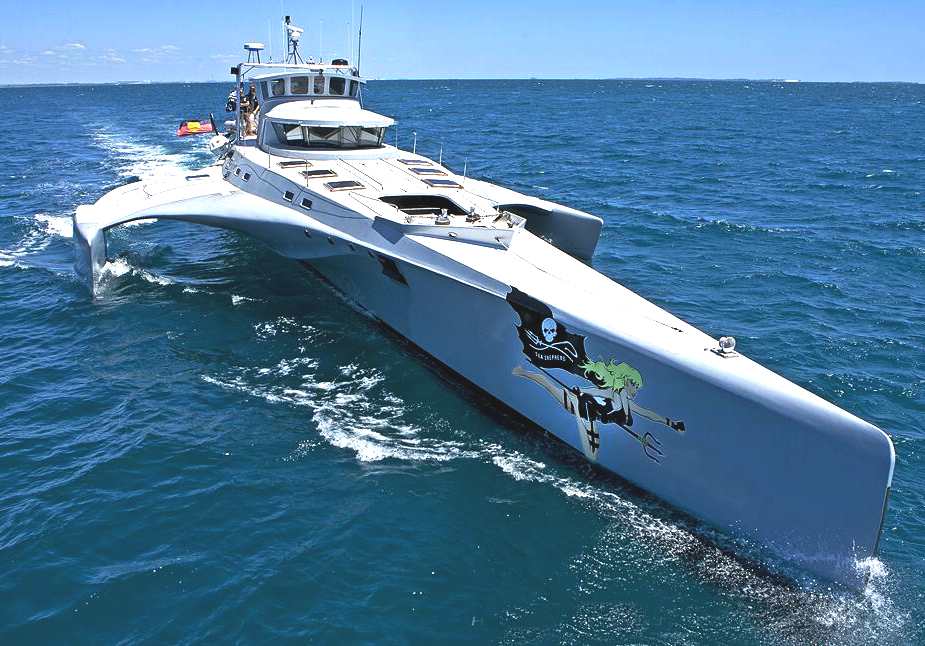
OCEAN
7 ADVENTURER
In 2007 the vessel was acquired by Ocean 7, a Cape Town based marine brokerage and charter operation. The vessel was recommissioned and transferred to a mooring at the V&A Waterfront. The vessel was available for charter, film work and the occasional marine rescue operation.
In December 2007 the Ocean 7 Adventurer was chartered to retrieve a demasted yacht, the IMOCA 60 Delta Dore from the Southern Ocean. The Delta Dore was partaking in the Barcelona World Race. The yacht skippered by Jérémie Beyou and Sidney Gavignet was at position 47°00 S 033° 25 E, nearly a thousand miles south east from
South
Africa, drifting slowly at between 1 and 2 kn (2 and 4 km/h) east. An hour after the mast had collapsed backwards, it had to be cut free and dumped into the ocean, as it was likely to damage the hull. The yacht had 188 l (41 imp gal) of diesel fuel on board, but this was insufficient to motor back to the mainland. The Ocean 7 team were approached with regard to salvaging the yacht. Skippered by co-owner David de Villiers, the Ocean 7 Adventurer set sail for the Southern Ocean and after locating the yacht, it was taken in tow with a 200 m (656 ft) line. This rescue set a record for the longest tow in
South African maritime history (850 nmi (1,574 km)).
During early June 2008 the Adventurer moved to the east coast of South Africa to observe the annual sardine run, after which it relocated to the southern end of Madagascar in July in search of waves amongst the reefs where the vessel was used as a live-aboard base for surfers and kite surfers. During September the Adventurer explored the Baron Islands off the Madagascar coast before returning to its base at the V&A Waterfront for the summer season, where it was available for day charters,
specialized trips and functions.
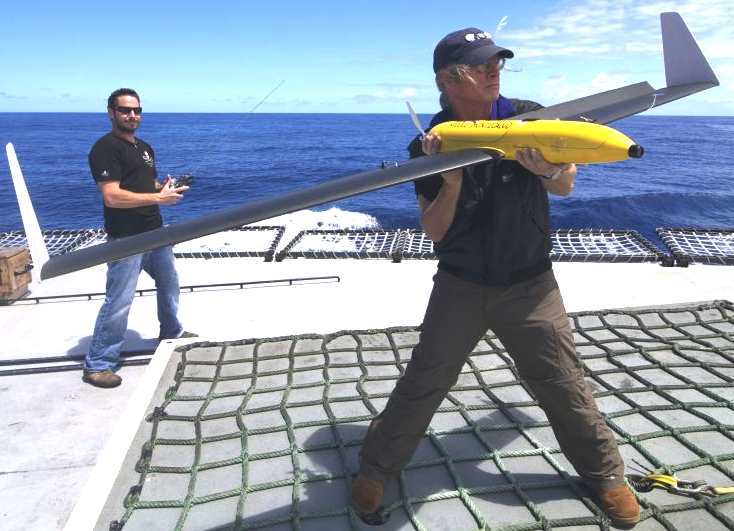
RAT
RACE MEDIA ADVENTURER
In 2008 it was repainted in Rat Race Media graphics and was the star of a TV series on kykNET, Aqua X. The series started in October 2008 and aired until January 2009.
MILES
FOR SMILES ADVENTURER
In November 2009 the Ocean 7 Adventurer was chartered by the Cipla Miles for Smiles Foundation to be the support vessel during leg one of the Miles for Smiles Madagascar Challenge. Before setting out to sea the Ocean 7 Adventurer received a new look with the iconic Miles for Smiles regalia. This challenge was the brainchild of David Grier to raise awareness and funding for Operation Smile children suffering from facial deformity. Leg one of this challenge was to paddle some 550 km (342 mi) from Nacala Mozambique to Cap St Andre in Madagascar where leg two of the challenge took place - the traversing of Madagascar from South to North on foot. The Ocean 7 Adventurer played a crucial role in supporting David Grier and cameraman Nick Heygate during the paddle crossing.
GOJIRA
The Sea Shepherd Conservation Society (SSCS) acquired the $4 million vessel for its 2010-11
campaign against
Japanese whaling in the Antarctic Southern Ocean Whale Sanctuary and renamed it MV Gojira (Romanized Japanese for
Godzilla). Captained by Lockhart
"Locky" MacLean, it is the first Australian-flagged vessel to be operated by the Sea Shepherd Society, and though slower, it is twice as large as the Ady Gil, making it more stable than the boat it replaces.
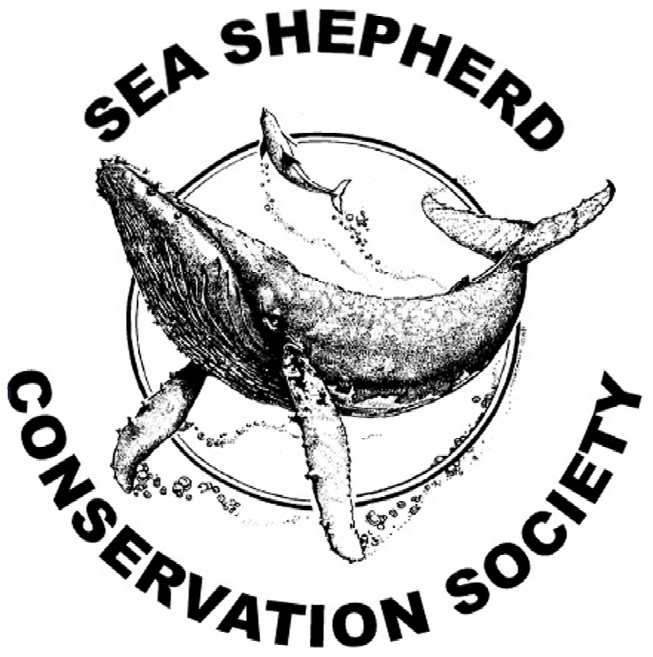
BRIGITTE
BARDOT
In May 2011 the SSCS was served with a notice from the copyright holders of the Gojira/Godzilla franchise, regarding the unauthorized use of the trademark. The Society promptly changed the vessel's name to the Brigitte Bardot in honor of the French fashion model, actress, and singer whom Paul Watson, the founder of Sea Shepherd, took on an
anti-sealing trip in 1977. In addition to a new name, the vessel also received a new paint scheme; the overall black scheme was replaced by a grey coloration similar to that of a naval vessel.
The ship, now under the command of Captain Jonathan Renecle, was damaged by a rogue wave of 11 m (36.1 ft) while pursuing the
Japanese whaling fleet off the western coast of
Australia on 28 December 2011. The Brigitte Bardot was escorted back to Fremantle by the SSCS flagship, MY Steve Irwin. The main hull was cracked and the port side pontoon was being held together by straps. The vessel arrived at Fremantle Harbour on 5 January 2012. Both ships were followed by the ICR security vessel MV Shōnan Maru 2 at a distance of 5 nautical miles (9 km).
The repair process, with a cost of over $250,000, involved placing the ship in a hermetically sealed chamber. Composite yacht experts from across the globe, including the ship's designer, were flown in to assess the damages and recommend a course of action. Sea Shepherd's 18 Australian chapters raised the money necessary to repair the vessel. Repairs to the MV Brigitte Bardot were completed and the ship set sail for sea trials on 16 April 2012.
In September 2012, the Brigitte Bardot was expelled from Fiji by local naval and immigration officials.
On 5 January 2013 in Timaru, New Zealand, a distress call was issued in relation to the Brigitte Bardot after an observer mistook the vessel for an overturned yacht. While several vessels nearby responded to the call, the Brigitte Bardot did not respond and instead turned away at high speed upon the arrival of a rescue helicopter. The South Canterbury Coastguard and Maritime
New Zealand criticised Sea Shepherd over the incident, stating "There was no need for Sea Shepherd to behave like this". Sea Shepherd founder Paul Watson said the first the organisation knew about the distress call was when the helicopter arrived. "We can't help it if someone else makes the call. There was nothing wrong with the ship," he said.

A
heartwarming adventure: pirate whalers
V conservationists battle it out in the Pacific
Ocean
with
a $Billion dollars riding on the conclusion.
LINKS
& REFERENCE
http://cmnnaval.fr/
http://www.maritimejournal.com/French-yard-building-surveillance-trimaran
Sea
Shepherd vessel MV Brigitte Bardot damaged by rogue wave drones deployed to
locate Japanese whalers
http://en.wikipedia.org/wiki/MV_Brigitte_Bardot
http://www.whoi.edu/alvin/
http://en.wikipedia.org/wiki/DSV_Alvin
http://en.wikipedia.org/wiki/Bathyscaphe_Trieste
|




